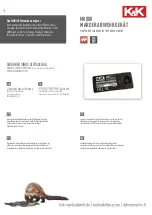
Van der Ende Pompen B.V.
Maasambacht 4
2676CW Maasdijk
Nederland
Installation manual Envalve series VK, VKF and PVK
Page 10 of 23
2. Description
In this chapter the machine is described, it is the background information needed to work safely with the
machine.
2.1 Working principle
The Envalve regulates the flow by means of turning a paddle in a housing. By turning the paddle, the
effective diameter of the pipe changes.
2.2 In general
The Envalve must be installed in a suitable piping system, only after installation is completely finished the
electric and/or pneumatic connections can be made.
With an Envalve, a flow of fluid media can be precisely controlled or stopped. Application examples are
the (continuous) mixing of two flows of fluid (VK an VKF series, double version) and the remote shutting
of pipes (all series).
The remote operation of the Envalve is possible because the drive is powered by electrics or pneumatics.
Normally there are two limit switches installed, but more position switches or a potentiometer can be
installed to read
(or read more precisely) the position of the Envalve. The position indicator (b) indicates
the position of the paddle. In case of a double version of the Envalve, the position indicator indicates the
position of the paddle of the valve directly under the drive.
The turning time
of the valve (the time in which the valve goes from fully closed to fully open) varies per
series: the VK and VKF take about 70 seconds (10 seconds is also available, ask the producer for
information), for the PVK this time depends on operating pressure and the pneumatic connections.
Optional is a flow regulator on the PVK, with this the turning time can be tuned.
The VKF and VK series are bistable, which means that when the power supply is cut off, the valve stays in
that position. The PVK series is monostable, the valve returns to its default position when the power
supply is interrupted (only if there is sufficient air pressure). Other configurations are available.
The connection between the Envalve and the piping for NW63 and smaller consists of a collar and a pvc
nut. At NW 75 and larger this connection consists of a collar, two flanges and some nuts and bolts.
For NW63 and smaller the Envalve has a seal made of EPDM (default) or FPM (optional) between the
paddle and the housing. And 2 O-ring seals between the valve and the collars.
From NW75 and larger the Envalve has only one seal, which sits between the housing and paddle and
between the valve and the collars.
2.3 Transport and storage
Transport and storage do not require special packaging but can not be stacked without special crates or
other precautions. The Envalve and the drive in particular is only moderately resistant to water and
moist, so the Envalve must be protected against both (see also paragraph 1.7).









































